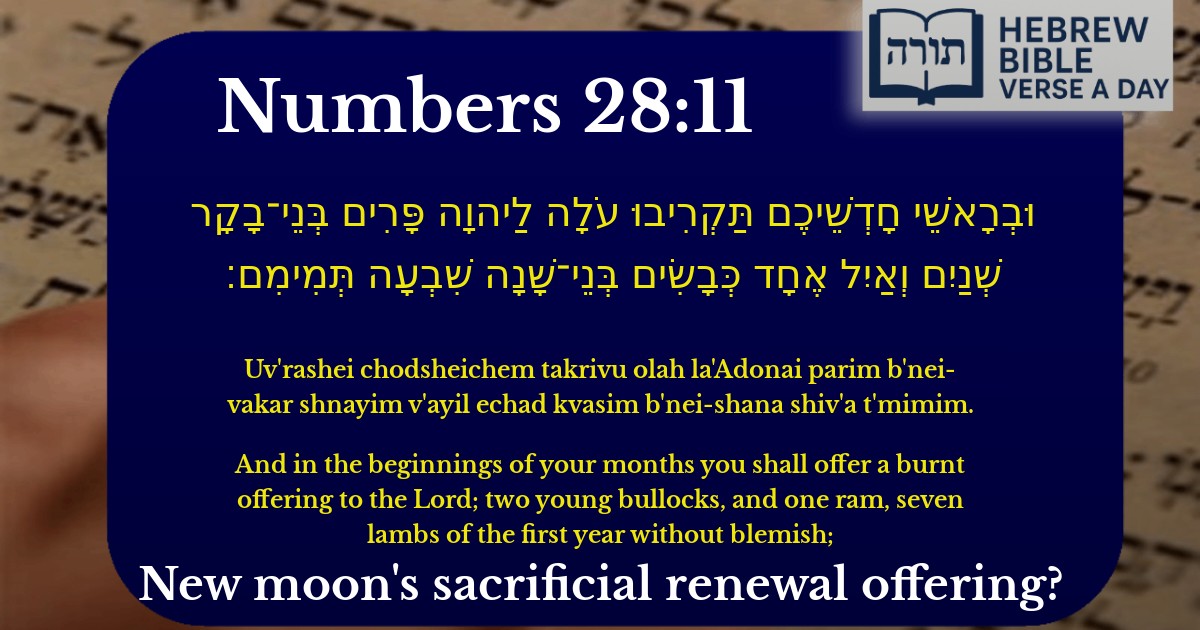Join Our Newsletter To Be Informed When New Videos Are Posted
Join the thousands of fellow Studends who rely on our videos to learn how to read the bible in Hebrew for free!
Hebrew Text
וּבְרָאשֵׁי חָדְשֵׁיכֶם תַּקְרִיבוּ עֹלָה לַיהוָה פָּרִים בְּנֵי־בָקָר שְׁנַיִם וְאַיִל אֶחָד כְּבָשִׂים בְּנֵי־שָׁנָה שִׁבְעָה תְּמִימִם׃
English Translation
And in the beginnings of your months you shall offer a burnt offering to the Lord; two young bullocks, and one ram, seven lambs of the first year without blemish;
Transliteration
Uv'rashei chodsheichem takrivu olah la'Adonai parim b'nei-vakar shnayim v'ayil echad kvasim b'nei-shana shiv'a t'mimim.
Hebrew Leining Text
וּבְרָאשֵׁי֙ חׇדְשֵׁיכֶ֔ם תַּקְרִ֥יבוּ עֹלָ֖ה לַיהֹוָ֑ה פָּרִ֨ים בְּנֵֽי־בָקָ֤ר שְׁנַ֙יִם֙ וְאַ֣יִל אֶחָ֔ד כְּבָשִׂ֧ים בְּנֵי־שָׁנָ֛ה שִׁבְעָ֖ה תְּמִימִֽם׃
Parasha Commentary
📚 Talmud Citations
This verse is quoted in the Talmud.
📖 Megillah 22b
The verse is referenced in a discussion about the sanctity of the New Moon and the offerings brought during this time.
📖 Rosh Hashanah 8a
The verse is cited in the context of discussing the significance of the New Moon and the specific sacrifices prescribed for it.
📖 Menachot 45a
The verse is mentioned in a discussion about the details of the offerings and their requirements.


The Significance of the Rosh Chodesh Offering
The verse (Bamidbar 28:11) commands the bringing of special korbanot (offerings) at the beginning of each month (Rosh Chodesh). Rashi explains that these offerings are in addition to the daily Tamid offerings, emphasizing the unique sanctity of Rosh Chodesh as a time of renewal. The Rambam (Hilchot Temidin u'Musafin 1:1) notes that these offerings are called "Musaf" (additional), highlighting their supplementary nature to the regular service.
Symbolism of the Animals
The Spiritual Message of Rosh Chodesh Offerings
The Kli Yakar explains that these offerings serve as atonement for the sin of the Golden Calf, which occurred when the people miscalculated Moshe's return at the beginning of a month. Thus, each Rosh Chodesh becomes an opportunity for spiritual renewal and correction of past errors. The Chatam Sofer adds that the variety of animals teaches that all aspects of our being - from the mighty bull (representing strength) to the gentle lamb (representing humility) - must be dedicated to divine service.
Practical Halachic Considerations
The Mishnah (Megillah 22b) discusses how the Rosh Chodesh offerings were brought even when the Temple stood, and their description here forms the basis for the Musaf prayer recited on Rosh Chodesh today. The Rambam (Hilchot Kiddush HaChodesh 5:1) emphasizes that the sanctification of the new month - which determines when these offerings are brought - is fundamentally tied to the human observation and court declaration of the new moon, showing the partnership between divine command and human action in Jewish practice.